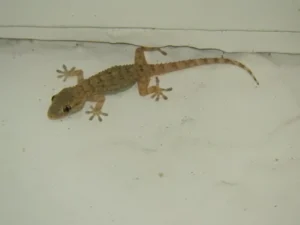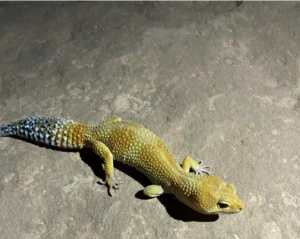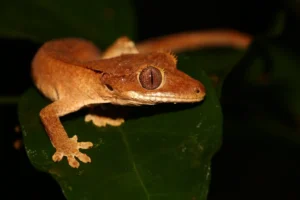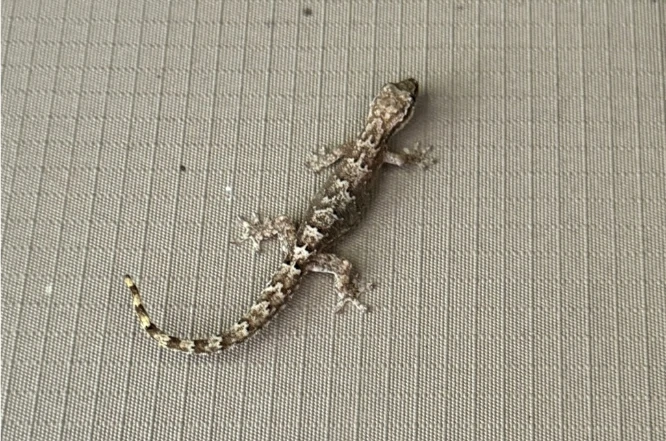If you’ve ever had a gecko or just watched one, you might wonder how they eat. Do they only go after live insects, or will they munch on dead ones too?
Geckos mostly eat live insects, but some will eat recently killed bugs if they’re fresh enough. They rely on movement to detect prey, so dead insects aren’t as attractive. Still, in captivity, geckos sometimes accept frozen-thawed or freshly killed insects, which makes feeding easier for pet owners.
How Geckos Hunt for Food
Geckos are mostly night hunters. They use their eyes, feel vibrations, and sometimes a strong sense of smell to find food.
Movement is really important, even the tiniest twitch can say, “Hey, food!”

That’s why live bugs work best. A gecko sees it move and strikes fast. In the wild, this is a big deal.
A missed meal could mean hours without food, so they’ve developed quick instincts to respond to movement almost automatically.
Why Dead Bugs Don’t Excite Them
Dead insects don’t move, so geckos might ignore them at first. They’re built to chase things that wiggle.
Still, if the dead bug is fresh (like one just killed by a human hand or another animal) some geckos will check it out and maybe nibble.
It’s not their first choice, but if they’re hungry or curious, they’ll give it a shot.
Pet owners often “wiggle” frozen-thawed insects with tweezers to copy movement. Geckos respond almost as well as they do to live prey.
Geckos in the Wild vs. Pets
In the wild, geckos almost always eat live bugs. Live prey gives them food and a little hunting challenge that keeps their reflexes sharp.
In captivity, things are different. Many pet geckos eat bugs humans give them, some of which are dead or thawed.
They adjust, but they still prefer live food if they can choose.
Dead insects are also safer. Some live bugs might bite, sting, or carry parasites. Dead ones remove that risk but still give good nutrition.
Examples of Dead or Frozen Bugs Geckos Eat
Pet owners often feed geckos safe, prepared insects:
-
Mealworms: Usually dead or thawed; geckos enjoy them.
-
Crickets: Sometimes frozen and thawed, then wiggled to make them move.
-
Waxworms or small moths: Can be fresh or lightly frozen.

Even if they’re not moving naturally, geckos can adapt if the bug looks and smells right. Freshness and a little wiggling usually do the trick.
How Geckos Find Food
Movement isn’t everything. Geckos also rely on:
-
Vision: Seeing shapes, shadows, and contrasts of insects.
-
Vibrations: Feeling tiny movements on surfaces like walls or leaves.
-
Smell or chemical signals: Detecting nearby insects, especially fresh ones.
Dead bugs lose a lot of these signals over time, which is why old bugs are ignored. The fresher the bug, the more likely a gecko will check it out.
Hunger Changes How They Act
When geckos are really hungry, they might take more risks and nibble on dead or nearly dead bugs.
In captivity, if live bugs aren’t around, geckos usually accept thawed insects or lightly wiggled dead prey.
In the wild, though, they stick to moving bugs. Hunger makes them try new things, which is why pet geckos sometimes surprise owners by eating bugs they usually ignore.
Can Geckos Survive on Only Dead Bugs?
Geckos can survive on dead bugs in captivity if they’re fresh and healthy.

But only feeding on pre-killed bugs for a long time isn’t very interesting for them and can change their hunting habits.
In the wild, they need live prey to keep reflexes sharp and stay fit.
A gecko that only finds still insects could miss too many meals and eventually starve.
Watching Geckos Eat
Watching a gecko hunt is really cool. They sneak slowly, sometimes freezing in place as they focus on a moving bug. When the time’s right, they strike fast and precise.
If you give them a dead or thawed bug, they might hesitate at first, sniffing or tapping it with their tongue or nose.
If it smells fresh or moves a little, they’ll eat it. This shows they can adjust but still rely on instincts from the wild.
Some Geckos Like Dead Bugs More Than Others
Some species are more willing to eat dead prey:
-
Leopard geckos: Often take thawed bugs easily. They live on the ground and adapt well to human feeding.
-
Crested geckos: Prefer live bugs but may nibble on fresh dead ones, especially if you make them move a little.
-
House geckos: Usually hunt live prey but will take easy meals if bugs are fresh or slightly moving.

These differences come from how they naturally hunt in their home environments.
Tips for Feeding Dead Bugs
If you feed your gecko dead or frozen bugs, these tips help:
-
Thaw insects first: Warm them a bit to make them more appealing.
-
Copy movement: Wiggle them lightly with tweezers.
-
Serve fresh bugs: Old or dried ones usually get ignored.
-
Offer variety: Different bugs keep your gecko interested and healthy.
Copying natural cues makes feeding dead bugs almost as good as live ones.
Geckos and Nutrition
Live or freshly dead, bugs give protein, fat, and sometimes calcium if dusted in captivity.
Geckos get energy from moving prey but don’t need movement for nutrients, it just helps them hunt. Dead bugs are fine as long as they’re fresh and safe.
That’s why pet owners can feed thawed or lightly killed bugs without hurting their gecko.
How Geckos Use Their Tongue
When a gecko checks a dead bug, it flicks its tongue across it. This isn’t just tasting, it’s picking up chemical signals that tell them it’s food.
Even a dead bug can seem alive if it smells right. That’s why fresh dead prey works, but older insects get ignored.
Why They Prefer Live Bugs
Even though geckos adapt, they usually like live prey better. Hunting live bugs gives them:
-
Mental stimulation: The chase keeps them alert.
-
Exercise: Chasing strengthens their muscles.
-
Hunting practice: Reflexes stay sharp, which is very important in the wild.
Dead bugs can work, but they don’t give the same benefits for behavior and instincts.
What Happens If They Only Get Dead Bugs
If a gecko only eats dead bugs in captivity, it will survive if they’re fresh and healthy.
Over time, though, it might get less active or lose some hunting instincts.
In the wild, this almost never happens. Geckos rely on movement to find food.
A gecko ignoring moving bugs would struggle to survive fast.
Observing Dead vs. Live Bugs
Many gecko owners notice their gecko pokes or bats at a dead bug before eating.
Live prey triggers instant action, but dead bugs need more checking.
Some geckos even carry a dead bug around like they’re testing it. This shows how their hunting instincts guide them.
Conclusion
So, do geckos eat dead bugs?
Geckos mainly live by hunting live prey. Movement is very important to trigger their hunting instincts. Still, they’re flexible and can eat freshly killed or thawed bugs, especially in captivity.
Dead bugs are fine if fresh and safe, but live bugs are always better because they keep geckos active, sharp, and engaged.
Whether you watch a gecko in your backyard at night or feed a pet, remember: geckos hunt by instinct.
They can eat dead bugs, but their world is full of movement, and that’s what keeps them alive and thriving.
Hi, my name is Ezra Mushala, i have been interested animals all my life. I am the main author and editor here at snakeinformer.com.

